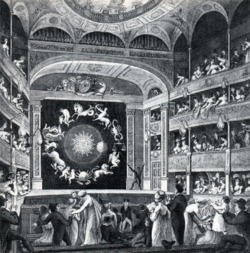Engineering:Eidouranion
An eidouranion is a kind of orrery that combined mechanical movement with a method of back projection. Its invention is attributed to Adam Walker (1731-1821)[1] who in the 1780s[2] built one measuring 27 feet in diameter. He used it to accompany his lectures on astronomy. It is an ancestor of planetarium projectors.
It is known that Adam Walker held lectures featuring the Eidouranium at the Royal Theatre in London in the 1780s[3] and the London Lyceum.[4] The shows were continued by his eldest son, William Walker (1767-1816), from around 1812.[1] The shows were continued through the 1820’s by William’s younger brother Deane Franklin Walker (1778-1865).[1]
The word "eidouranion" derives from the Greek compound "eid + ouranos".[5] The combining elements are "eidos", which means "what is seen, shape, form",[6] and "ouranos", which was the name of the god of the heavens.[7] Thus, the combined form means "shaped like the heavens" or "formed like the heavens".
References
- ↑ 1.0 1.1 1.2 "1977JBAA...88...32G Page 32". https://articles.adsabs.harvard.edu//full/1977JBAA...88...32G/0000032.000.html.
- ↑ "Glossary of the Magic Lantern Society". Archived from the original on 2012-02-13. https://web.archive.org/web/20120213181500/http://www.magiclantern.org.uk/alphabet/alphabetef.html.
- ↑ Lankford, John (1997). History of astronomy: an encyclopedia. p. 405. ISBN 9780815303220. https://books.google.com/books?id=berWESi5c5QC&pg=PA405.
- ↑ During, Simon (2002). Modern Enchantments: The Cultural Power of Secular Magic. p. 219. ISBN 9780674013711. https://books.google.com/books?id=2eEK-55hgKMC&pg=PA219.
- ↑ Webster's New International Dictionary (Second ed.). The Riverside Press, Cambridge, MA USA: G. & C. Merriam Co. 1950.
- ↑ "eid". http://www.cognatarium.com/cognatarium/?K=eid&P=Search+Morphemes. Retrieved January 28, 2015.
- ↑ "Uranus". http://www.britannica.com/EBchecked/topic/619280/Uranus. Retrieved January 28, 2015.
Further reading
- King, Henry C, and John R. Millburn. Geared to the Stars: The Evolution of Planetariums, Orreries, and Astronomical Clocks. Toronto: University of Toronto Press, 1978. Print. [esp. Ch. 19: The Eidouranion and Other Large Transparent Orreries]
External links
 |


